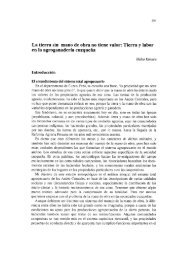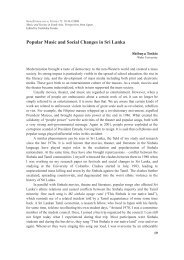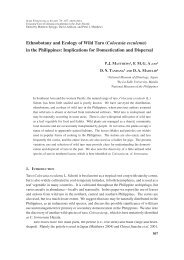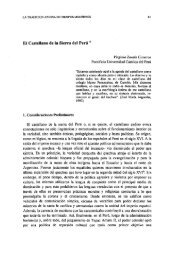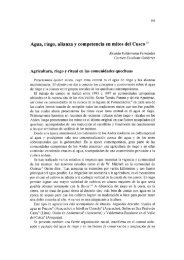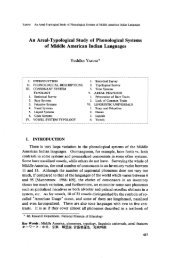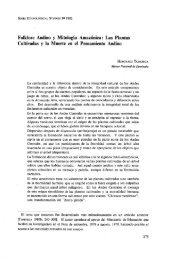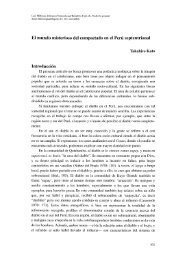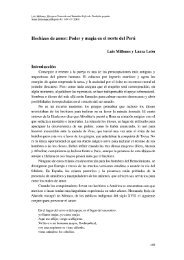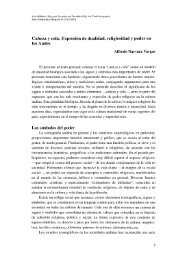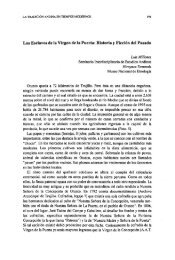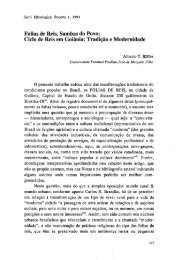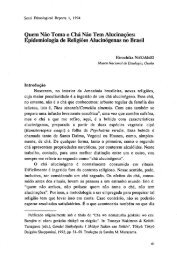The Sixteen Bodhisattvas in the Dharmadhatu ... - 国立民族学博物館
The Sixteen Bodhisattvas in the Dharmadhatu ... - 国立民族学博物館
The Sixteen Bodhisattvas in the Dharmadhatu ... - 国立民族学博物館
You also want an ePaper? Increase the reach of your titles
YUMPU automatically turns print PDFs into web optimized ePapers that Google loves.
Tachikawa <strong>The</strong> <strong>Sixteen</strong> <strong>Bodhisattvas</strong> <strong>in</strong> <strong>the</strong> <strong>Dharmadhatu</strong> Mandala<br />
(14) Pratibhanakuta<br />
<strong>The</strong> four Pratibhanakuta images (Figures 75-79) , except for <strong>the</strong> one <strong>in</strong><br />
Sva-C1 (Figure 77), have <strong>the</strong> same symbols: a chotika gesture (a small circle<br />
made by jo<strong>in</strong><strong>in</strong>g <strong>the</strong> tip of a thumb and third f<strong>in</strong>ger) of <strong>the</strong> right hand and a<br />
sword on a lotus flower <strong>in</strong> <strong>the</strong> left hand. Pratibhanakuta <strong>in</strong> Sva-C1 has a<br />
sword on a lotus flower <strong>in</strong> <strong>the</strong> right hand, but it is not clear whe<strong>the</strong>r he has <strong>the</strong><br />
chotika gesture or not: <strong>the</strong> f<strong>in</strong>gers of <strong>the</strong> right hand are not separately depicted.<br />
One may say that <strong>the</strong> symbols of <strong>the</strong> five Bodhisattva images are almost <strong>in</strong> all<br />
cases <strong>in</strong> accordance with <strong>the</strong> description given <strong>in</strong> <strong>the</strong> NPY.<br />
(15) Sarvasokatamonighatamati<br />
All <strong>the</strong> five Sarvasokatamonighatamati images show <strong>the</strong> same symbols: a<br />
vajra <strong>in</strong> <strong>the</strong> right hand and a sakti <strong>in</strong> <strong>the</strong> left hand (Figures 80-84) . <strong>The</strong> term<br />
"sakti" means a short lance , known as one of <strong>the</strong> weapons of Karttikeya, a son<br />
of Siva. Here <strong>in</strong> <strong>the</strong> cases of <strong>the</strong> five Newar images of <strong>the</strong> Bodhisattva, a sakti<br />
is depicted as a three-po<strong>in</strong>ted weapon.<br />
<strong>The</strong> NPY states that he holds a five-po<strong>in</strong>ted vajra <strong>in</strong> <strong>the</strong> right hand and a<br />
sakti <strong>in</strong> <strong>the</strong> left hand. Hence, one may say that <strong>the</strong> symbols of <strong>the</strong> five Newar<br />
images accord with <strong>the</strong> description given <strong>in</strong> <strong>the</strong> NPY.<br />
(16) Sarvanivaranaviskambh<strong>in</strong><br />
From <strong>the</strong> viewpo<strong>in</strong>t of <strong>the</strong> symbols, one may divide <strong>the</strong> five images of <strong>the</strong><br />
Bodhisattva <strong>in</strong>to two groups: <strong>the</strong> first group of Kva-C (Figure 85) , Uku-C<br />
(Figure 86) and Sva-M (Figure 89) , and <strong>the</strong> second group of Sva-C1 (Figure<br />
87) and Sva-C2 (Figure 88) . All <strong>the</strong> three images of <strong>the</strong> first group show a<br />
sword <strong>in</strong> <strong>the</strong> right hand and a double vajra on top of a flag <strong>in</strong> <strong>the</strong> left hand.<br />
<strong>The</strong>se are <strong>the</strong> same symbols mentioned <strong>in</strong> <strong>the</strong> NPY. <strong>The</strong> two images of <strong>the</strong><br />
second group hold totally different symbols: a boon-giv<strong>in</strong>g gesture of <strong>the</strong> right<br />
hand and a book on a lotus flower <strong>in</strong> <strong>the</strong> left hand. We do not know on which<br />
tradition <strong>the</strong> images of <strong>the</strong> second group are based.<br />
4 Three <strong>Dharmadhatu</strong> Mandalas <strong>in</strong> Patan<br />
In <strong>the</strong> courtyards of Buddhist temples <strong>in</strong> Patan City <strong>the</strong>re are, at least,<br />
three copper or brass plates on which <strong>the</strong> ma<strong>in</strong> deities of <strong>the</strong> <strong>Dharmadhatu</strong><br />
Mandalas are depicted. Those three mandala plates are found <strong>in</strong> Haka<br />
(Hakha) Bahal, Nah Bahal, and Bu Bahal. In Tachikawa (1999: 699-808) I<br />
have exam<strong>in</strong>ed <strong>the</strong> deities depicted <strong>in</strong> <strong>the</strong> three mandala plates. In each<br />
mandala plate one can see draw<strong>in</strong>gs of <strong>the</strong> <strong>Sixteen</strong> <strong>Bodhisattvas</strong>. It seems that<br />
<strong>the</strong> three mandalas follow <strong>the</strong> same tradition. <strong>The</strong> symbols of deities are<br />
almost identical <strong>in</strong> each mandala. Unfortunately, <strong>the</strong> size of <strong>the</strong> draw<strong>in</strong>g of<br />
each Bodhisattva is so small (3-4 square cm.) that not every symbol held <strong>in</strong> <strong>the</strong><br />
549



